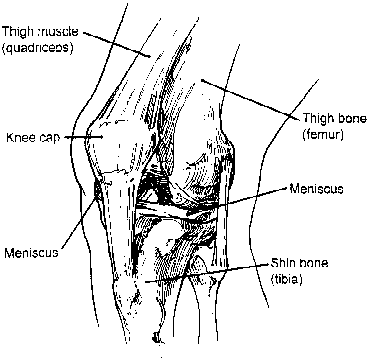The Knee
These articles are for general information only and are not medical advice. Full Disclaimer. All articles compliments of the AAOS.
About 19.4 million visits were made to physicians’ offices in 2003 because of a knee problem (Source: National Center for Helath Statistics; Centers for Disease Control and Prevention; 2003 National Ambulatory Medical Care Survey.) It was the most common reason for visiting orthopedic surgeons.
There are many components to the knee making it vulnerable for various types of injuries. Many injuries are successfully treated conservatively, while others require surgery to correct. Here are some facts about the knee from the American Academy of Orthopaedic Surgeons.
How does the knee work?
The knee is the largest joint in the body, and one of the most easily injured. It is made up of the lower end of the thighbone (femur) which rotates on the upper end of the shinbone (tibia), and the knee cap (patella) which slides in a groove on the end of the femur. The knee also contains large ligaments which help control motion by connecting bones and bracing the joint against abnormal types of motion. Other parts of your knee, like cartilage, serve to cushion your knee or help it absorb shock during motion.
What are the most prevalent knee injuries?
Many athletes experience injuries to their knee ligaments. Of the four major ligaments found in the knee, the anterior cruciate ligament (ACL) and the medial collateral ligament (MCL) often are injured in sports. The posterior cruciate ligament (PCL) also is frequently injured.
Changing or twisting direction rapidly, slowing down when running, and landing from a jump are often the causes of tears in the ACL. Athletes participating in skiing and basketball and athletes wearing cleated shoes, such as football players, are susceptible to ACL injuries.
Injuries to the MCL usually are caused by contact on the outside of the knee. These types of blows to the knee often are encountered in contact sports such as football.
The PCL can be injured during a sports activity when the athlete receives a blow to the front of the knee or makes a simple misstep on the playing field. Athletes engaging in contact sports such as football or soccer are susceptible to a PCL injury.
Other than ligament injuries, are there any other types of injuries?
Torn knee cartilage is experienced by many people. When people talk about torn knee cartilage, they usually are referring to a torn meniscus. The mensicus is a tough, rubbery cartilage that is attached to the knee’s ligaments. It acts like a shock absorber.
In athletic activities, mensicus tears usually occur when twisting, cutting, pivoting, decelerating, or being tackled. Direct contact is often involved.
How are knee injuries treated?
There are a variety of methods used by orthopedic surgeons to treat knee injuries in athletes. The most important advice is to seek treatment as soon as possible. A common method used by orthopedic surgeons to treat mild knee injuries is R.I.C.E.-rest, ice, compression, and elevation. Rest the knee by staying off it or walking only with crutches. Apply ice to control swelling. Use a compressive elastic bandage applied snugly but loosely enough so that it does not cause pain. Finally, keep the knee elevated.

